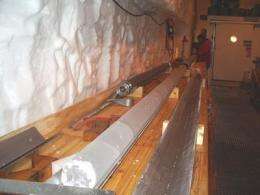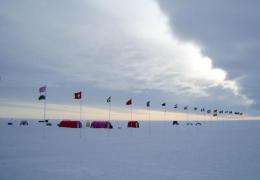Searching for an interglacial on Greenland

The first season of the international drilling project NEEM (North Greenland Eemian Ice Drilling) in north-western Greenland was completed at August 20th.
A research team, with the participation of the Alfred Wegener Institute for Polar and Marine Research in the Helmholtz Association, has drilled an ice core of altogether 1757.87 m length on the Greenland inland ice within 110 days. It is expected to contain data on climate history of about 38.000 years. The oldest ice comes from a period when the Greenland climate was characterized by strong temperature fluctuations: an average of 10° to 15° Celsius within a few centuries. The drilling is to be continued in the coming years to gain information on the last interglacial period, the Eemian of about 120.000 to 130.000 years ago.
Research institutes from fourteen nations are participating in the research project which is running since 2007: Denmark, the USA, France, Sweden, the Netherlands, Japan, Great Britain, Germany, South Korea, Switzerland, China, Belgium, Iceland and Canada. NEEM is one of the major projects of the International Polar Year 2007-2009. It is coordinated logistically by the Centre for Ice and Climate in Denmark.

The international team has been drilling an ice core in north-western Greenland (77°45'N - 51°06'W) since April this year. The ice cover at the location has a magnitude of 2.545 m and it is meant to be completely drilled in the coming years to make Eemian climate data of about 120.000 to 130.000 years ago accessible. The gases, trace elements and biological substances enclosed in the ice allow the reconstruction of climate conditions at that time. "So far, we lack detailed information on the climate in Greenland during the last interglacial", explains Prof. Frank Wilhelms, glaciologist at the Alfred Wegener Institute.
"With the help of data gained from the ice core and particularly from the comparison with data from an ice core we drilled in the Antarctic Dronning Maud Land, we are for the first time able to draw conclusions on the interaction of the climate on the northern and southern hemisphere during that time", Wilhelms continues. Because the drilling in this year could be conducted so successfully, researchers expect to obtain ice with the necessary information on this climate period in the summer of 2010.
Source: Helmholtz Association of German Research Centres (news : web)



















